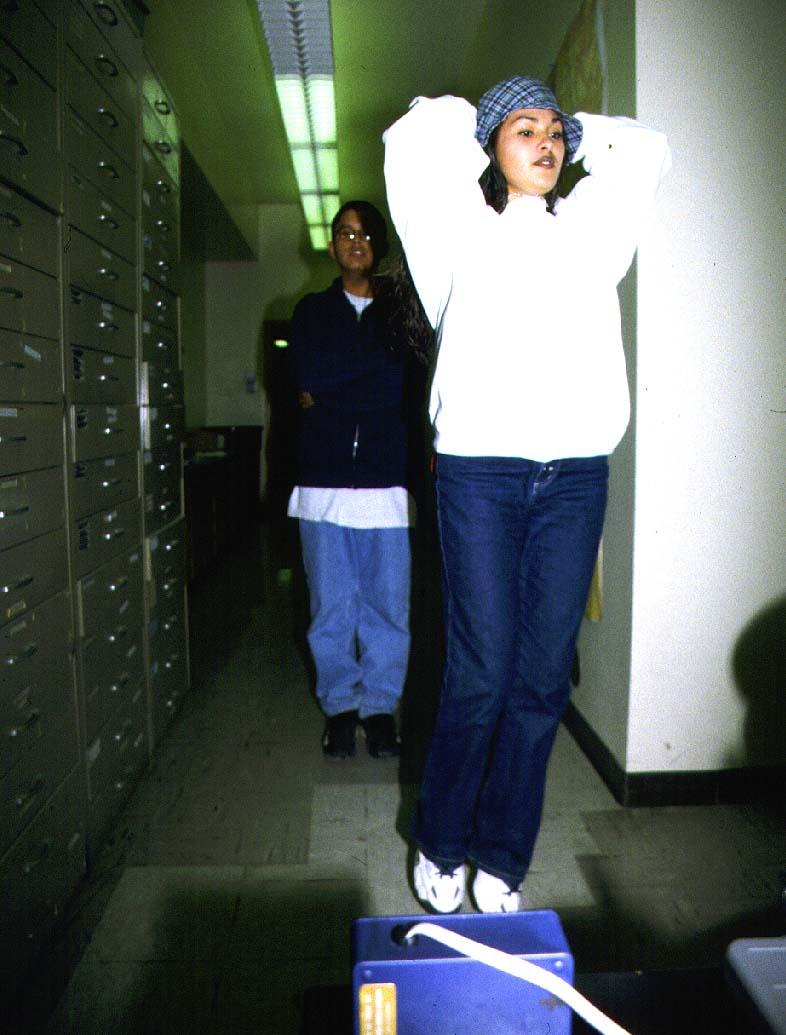Four Corners Upward Bound Program
Calculator Based Laboratory
Keri Garver
Walk This Way: Exploring
Functions with Body Motions

Experiment Setup:
-
Connect the CBL unit to the TI-83 calculator with the unit-to-unit link
cable using the I/O ports located on the bottom edge of each unit. Press
the cable ends in firmly.
-
Connect the motion detector to the SONIC port on the left side of the CBL
unit.
-
Turn on the CBL unit and the TI-83 calculator.
-
Place the motion detector on the table so it will detect the movement of
a student walking away from or towards the detector.
Experiment Procedure:
-
Clear a walkway in the area in front of the motion detector. Be sure that
the walkway is wide enough so that no one else except the walking student
will have their motion detected by the detector.
-
The motion detector should be perpendicular to the line of motion of the
walker and sitting flat on the table.
-
The walking student must walk beyond 1.5 feet from the motion detector
because the detector cannot detect objects closer than that distance.
-
The detector takes measurements in feet every 0.1 seconds for 6 seconds
and displays the graph of the collected data on the calculator.
-
Press the PRGM key on your calculator. This will bring up a list of programs
on your calculator. Move downwards on you screen using the arrow key until
you see the program HIKER highlighted. Press ENTER to bring up the display
prgm HIKER.
-
Press ENTER to start the program., the TI copyright screen appears. Once
you have read the screen, press ENTER on the TI-83.
-
The program pauses to remind you to turn on the CBL at this time. Once
you have done so press ENTER.
-
The program then checks the connection between the calculator and the CBL.
Once the connection is o.k., press ENTER on the calculator.
-
The program will pause with a message PRESS ENTER TO START GRAPH. When
you and the walker are ready, tell the walker to start walking after you
press ENTER and hear the clicking sound from the detector.
-
A graph of the Distance (y-axis) versus Time (x-axis) is plotted on the
TI-83 as the data is collectied. When the walker has a reasonably good
graph, move to the analysis section of the lab below. To get the data (in
ordered pairs (x, y)) needed for analysis, press TRACE and move along the
plotted points.
Analysis:
1. Take turns being the walker for each of the following graphs.
Draw a rough sketch of your graph, and discuss with your group what the
walker had to do to obtain the graph. Write a careful and complete explanation
of what the walker did. Use the TRACE key to find the end points of each
line (a through e) and use these points to express distance as a function
of time. (hint: y = mx + b) where m = slope and b = y-intercept.
a) Line with an upward (positive)
slope.

b) Line with a steeper upward slope.

c) Describe what you did differently in part (b).
d) Line with a downward (negative)
slope.

e) Line with a less steep downward slope.

f) A horizontal line.

g) An U-shaped curve opening up.
h) An U- shaped curve opening
down.
2. With your group, think about the graphs you have made and answer
the following questions:
a) What does the graph look
like when a person is not moving?
b) How can you tell from a graph
whether a person is walking or running?
c) How can you tell which direction
a person is moving from a graph?
d) How can you tell where a
person started from by looking at a graph?
Interpretation:
The following graphs were obtained using the CBL- motion detector system.
For each graph, describe the starting and ending point and how fast you
would have to walk in between the two points.
(a)

(b)

(c)

Try to obtain as best you can each of the following graphs using the
CBL system. For each graph, describe carefully what the walker had to do
to obtain the graph. Include as much information as possible, such as where
the walker started, stopped, and how fast he/she walked. If you cannot
obtain the graph, explain why it is impossible.
(i)

(ii)

(iii)

(iv)

(v)

(vi)

(vii)

(viii)

(x)

(xi)

Each individual in your group should complete this separately.
Assessment:
Sketch a rough graph to describe each of the following situations. Remember
to label your axes with the appropriate units.
a) Run as fast as you can for 10 seconds, stop for
10 seconds, and then walk for the rest of the time.
b) Walk for 10 seconds, run as fast as you can for 20
seconds, and then walk again for 10 seconds.
c) Cindy set off for school one morning. When she was
half way there, she remembered she had left a book at home. She went
back to get it. Then she realized that she was going to be late so she
hurried all the way to school.
d) Walk for 20 seconds, turn and walk back towards your
starting point for 10 seconds, then turn around and walk away from the
starting point for 5 seconds.
e) John went downhill on his skateboard, speeding up
as he went. At the bottom of the hill, he ran into the curb and came to
a sudden stop.
send me an email
return to main page
return to astromath
![]()
![]()
![]()
![]()
![]()










